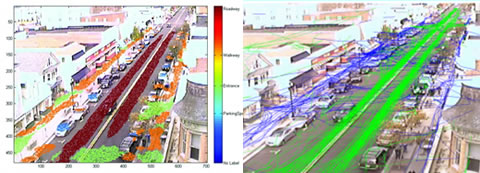
The Defense Advanced Research Projects Agency (DARPA) is moving forward with groundbreaking programs providing the warfighter persistent, wide area coverage of large areas, enabling joint forces at tactical and operational levels cunducting ubiquitous, monitor of urban or rural areas, attempting to alert, intercept and eliminate hostile elements in a secured area, requireing minimal presence on the ground. DARPA and the U.S. Air Force have been supporting several programs developing platforms, sensors, image processing and analyst support systems, whicl will bring such capabilities to relity.
Since 2007 the U.S military has fielded the first generation of airborne wide area surveillance – namely the Army’s Constant Hawk and Air Force and Marine Corps Angel Fire. Analysts operating these systems try to determine all the entities going to and from an event or point of interest to ascertain the unique source of destination of the people or vehicles associated with a specific event. These manual tracks take many hours and are prone to human error. Furthermore, they result in text reports or simple sketches which cannot be processed by machines. Therefore, existing WAMI assets like Angel Fire are limited to a small number of subframes and used primarily for force protection. Events of interest can include staring points and destinations of tracks and nodes of related entities within the persistent field of view. They can also include activity and event-based normalcy and anomaly detections, such as unique driving behaviors occurring before the detonation of suicidal vehicle. Other types of events can be used to discover or highlight ‘patterns of life’ associated with a variety of network types, including social, political, regional, economic or military networks.

WAMI surveillance efforts are directed primarily around roads, buildings and distinctive scene features. Exploitation of these entities yields tracks but, in a complex urban environment these tracks are severely fragmented due to occlusions, stops and other factors involving irregularities. PerSEAS will use advanced algorithms to associate these track fragments to identify localized events and discover relationships and anomalies that could be indicative of suspicious behavior, match previously learned threat activity, or match specific, user defined patterns. While a localized event may occur over a small ‘window’ of time and space, the overall activity sequence may span over much longer time and wider area – PerSEAS will be able to track, link and highlight as potential threat activity, by pooling together multiple weak pieces of evidence, the system’s engine should be able to detect a potentially threatening activities.
Persistent Stare Exploitation and Analysis System (PerSEAS) is a software system developed to automatically and interactively discover actionable intelligence from wide area motion imagery (WAMI) of complex urban, suburban and rural environments. Used in a forensic mode, the system will exploit hours and days of WAMI data to identify threat activities and the underlying threat indicators. Used in a near real-time mode, the system will alert the user to developing threat activities intime to interdict. In addition to the electro-optical/infrared (EO/IR) data available from WAMI sensors, PerSEAS will interact with other intelligence sources. Overall, the system will significantly reduce the time required to perform current exploitation tasks and greatly enhance the analysts’ ability to exploit the huge volume of imagery data available to them.
DARPA awarded Kitware Inc. a US$13.8 million contract for the development of image analysis support for wide area motion imagery (WAMI) systems. Kitware is developing these new workstations as part of the Persistent Motion Imagery Analysis Tool for Exploitation (PerMIATE) program, assisting analysts in discovering and analyzing high-value intelligence content embedded in massive amount of WAMI data, both online and forensically. Leveraging advanced computer vision, machine learning, artificial intelligence, and data visualization in an integrated workstation PerMIATE will reveal and highlight the most critical information in a clear and intuitive presentation, enabling video analyst to quickly validate or refute intelligence leads through deep exploration of the underlying evidence, resulting in substantial reductions in analyst workload as well as increasing the quality and accuracy of intelligence yield.
Persistent surveillance capabilities like those available by PerMIATE require platforms with extremely long endurance. The U.S. military is considering several alternatives for these tasks, including the A160 Hummingbird rotary-wing UAV, a tethered aerostat platform or an airship.
















